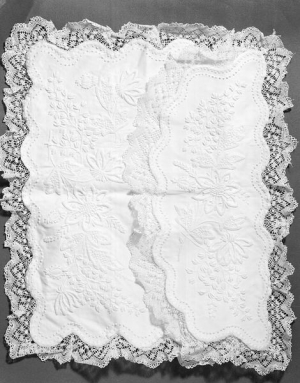Mountmellick embroidery is characterised by the use of a thick, white cotton thread (sometimes called Mountmellick cotton) on a white cotton ground (often a white cotton satin, which is sometimes described as a cotton satin jean). The work is strongly textured, with an emphasis on flat and raised stitches (especially well padded satin stitch and French knots). In the late twentieth century a wide range of stitches were used for this type of work, including blanket stitch, bullion stitch, buttonhole stitch, chain stitch, coral stitch, couched satin, detached chain stitch, feather stitch, leaf fill, etc.
Traditionally, the motifs used reflect wild flowers and fruits found in and around Mountmellick, especially along the Owenass River. The plants include acorns and oak leaves, blackberries, dog roses, fern, ivy and shamrocks. By the end of the twentieth century a range of cultivated plants was also being used for the designs, including daffodils, cyclamens, passion flowers, snowdrops and tiger lilies. In addition, birds, butterflies and seashells started to be included. The finished items often have a knotted fringe. This type of embroidery was mainly used for household linens such as bedspreads, mats, tray cloths and so forth.
It is generally accepted that Mountmellick embroidery was developed in c. 1825 by Joanna Carter, who ran a small (Quaker) school in Mountmellick in order to teach young girls various types of embroidery. Another woman associated with its early development is Margaret Beale, a Quaker lace maker from Enniscorthy (Co. Wexford).
The establishment of the school took place as part of a wider, early nineteenth century trend of introducing various types of lace, needlelace and needlework in Ireland (such as Limerick lace, Carrickmacross lace and muslin embroidery), in order to teach poor girls a trade and to pay for their education. It would seem that the craft of Mountmellick embroidery declined after the death of Joanna Carter (date unknown).
Interest in Mountmellick embroidery was revitalised in c. 1880 by Mrs. Millner, a Quaker who established the Industrial Society of Mountmellick for Distressed Gentlewomen. She employed local women to stitch Mountmellick embroidery for sale. By 1890 there were some fifty women employed to produce embroidery. Mountmellick embroidery became more well-known via Weldon’s Practical Needlework, which published various Mountmellick designs between 1890-1898 (Weldon’s Practical Mountmellick Embroidery, London: Weldon Publishers).
The popularity of this type of work declined due to the First World War (1914-1918) and the imitation of this type of work by cheaper, mechanical means. Mountmellick embroidery had virtually vanished by the mid-twentieth century. In the early 1970's, however, Sister Teresa Margaret McCarthy (Presentation Convent, Mountmellick) started to collect old examples, was taught the techniques by various old nuns in the convent and then taught others the techniques, so re-introducing this style of embroidery. This work was aided by the donation of a large number of early embroidery designs by the Pim family of Mountmellick. There are now various groups in a number of different countries producing Mountmellick embroidery.
Sources:
- MORRIS, Barbara (1962). Victorian Embroidery, London: Herbert Jenkins, p. 40.
- COUNAHAN, Sandra (2005). Traditional Irish Embroidery: Mountmellick Work, Cork: Mercier Press, p. 7.
- STANTON, Yvette (2007). Mountmellick Embroidery: Inspired by Nature, Vetty Creations (a self-publication; Australia).
- TROTT, Pat (2002). Beginner’s Guide to Mountmellick Embroidery, Tunbridge Wells (UK): Search Press.
- http://islandireland.com/Pages/folk/mountmellick/embroidery.html
- http://www.mountmellickdevelopment.com/quaker-heritage-families.htm.
V&A online catalogue (retrieved 6 July 2016).
GVE

